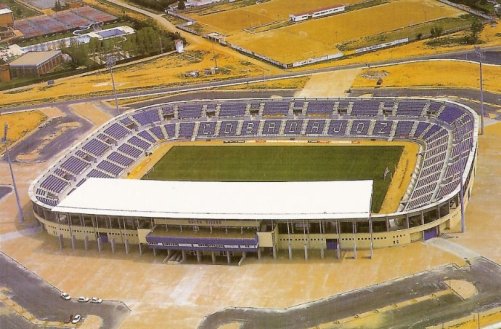For 107 years, the primary focus for football in in this city on the Portuguese border was Club Deportivo Badajoz. That heritage came to a calamitous end in the summer of 2012, and it could be argued that this new stadium played a part in the club’s demise.

Founded in August 1905, CD Badajoz spent 81 years at the Campo de El Vivero. This was a basic ground to the north of the Rio Guadiana, and it hosted second division football as recently as 1998. El Vivero was hopelessly outdated, and with the club eyeing top-flight football, work commenced on a new stadium to the west of the city in September 1997. After 81 years north of the Rio Guadiana, CD Badajoz headed back to the south of the city and the Estadio Nuevo Vivero. The stadium was inaugurated on 2 December 1998 with a match friendly match against local rivals CF Extremadura that ended 0-0. The stadium staged its first competitive match 4 days later, with the second division tie against CD Toldeo. Regrettably, and possibly as a sign of things to come, CD Badajoz lost 0-1. Unfortunately, that dream of top flight football never quite came off and after spending beyond their means, particularly in the early 2000’s on a host of Argentinian players, CD Badajoz nearly popped its clogs. A last minute deal in July 2006 with the President of local amateur club AD Cerro de Reyes, saw CD Badajoz debts paid-off. There was a downside however, as they lost their place in Segunda B to his club. Very Faustian!

The Estadio Nuevo Vivero is the largest stadium in Extremadura with a capacity of 15,598. Situated on the south bank of the Guadiana, about a mile to the west of the city, it was built at a cost of 4.5 million euros with funding from Extremadura’s regional government. The stadium sits on the edge of a development of a series of sports facilities, of which the municipality is rightly proud. It is a bright, modern, if slightly formulaic stadium, featuring a single tier of black & white seats. The cantilevered roof on the west side of the stadium is impressive, snapping on to the supports like a giant white lid. The Nuevo Vivero was one of the stadiums included in Spain’s unsuccessful bid to host the 2018 World Cup. That would have seen the stadium increase to over 35,000, which bearing in mind CD Badajoz struggled to get a tenth of that, does seem ridiculous. It has seen international football however, with La Selección choosing the stadium to host three full internationals at the ground between 1999 and 2021. Spain has won all three matches with an aggregate of 16-0.

Following four seasons in the Tercera, CD Badajoz was promoted back to Segunda B for the start of the 2010-11 season. It proved to be a false dawn, for after two mid-table finishes, the club was wound-up with debts of over €8m. Badajoz’s football fans had to content themselves with Tercera division football and the exploits of UD Badajoz at the rebuilt Estadio Viejo Vivero, whilst the Nuevo Vivero lay empty. Then in the summer of 2013, UD Badajoz joined forces with Badajoz CF, who had emerged from the remnants of the old CD Badajoz, to form Badajoz Club de Fútbol. They changed their name to Deportivo Pacense in the summer of 2014, following the emergence of CD Badajoz 1905, a phoenix club who won promotion to the Tercera in June 2014 and Segunda B in 2017. The upshot of all of this is that the new CD Badajoz now resides in the spacious surroundings of the Estadio Nuevo Vivero.

1 thought on “Badajoz – Estadio Nuevo Vivero”